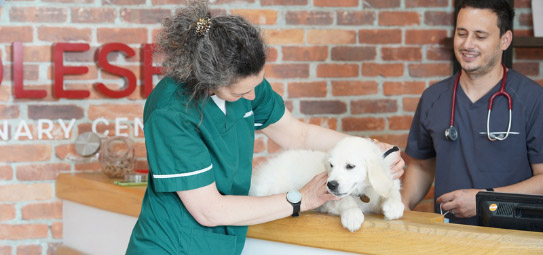
East Molesey Vets have this advice for work-from-home pet owners
June 21, 2022
Working from home has become considerably more common since the start of the pandemic. As a result, many cats and dogs in Surrey have become accustomed to their owners being in the house all day every day, which has created new challenges. Keep reading to get advice from the team at Molesey Veterinary Centre on how to create the ideal work-from-home environment to keep your pets happy too.
Our East Molesey Vets and Nurses have been hearing about “home worker pet problems” from partners, friends, family, and our clients, and felt it important to offer some advice on this topic to struggling pet owners.
Got an experience or tips for working at home alongside your pet you’d like to share? Post photos of your office buddies and their ‘issues’ on our Facebook page…
Creating a harmonious space for work & pets
As many cat and dog owners will agree, if you are in the house, you are fair-game to your pet – walkies, playtime, food, treats, snuggles on the sofa, and whatever else they desire! So, how do you keep your cat or dog happy and calm whilst being productive and professional at work? Our team at Molesey Vets have some suggestions for you:
1. Choose your office location wisely
If you do have a choice of where to locate your home office, our Vet Darren Partridge, recommends setting up in a quiet part of your house as far away from the front door as possible. This will help to avoid hearing your dog going into ‘high alert’ if someone knocks on the door or posts a letter through. If they are by your side, they may not even bark at all. Darren suggests trying a video doorbell so you can see when someone is coming and avoid a ‘situation’.
2. Introduce separation & boundaries
Everyone’s home-office setup and their pets’ behaviour will be different. Some people have a closed-off room, whilst others work in a communal space like a kitchen or living room. Some pets are happy to chill out and follow commands, whereas others can be reactive and unruly. Where your pet spends the working day will depend on how productive you can be with them around, and how well they adapt to this new dynamic. There are things you can do to help your pet, as we’ll explain, but having at least some degree of separation is a good idea. One option could be to have your pet’s bed in your home office and use another room for phone calls and zoom meetings.
3. Stick to a routine
Try to get into a work-day routine that fits around everyone’s needs as soon as possible. This will help your pet to understand what is expected of them when you’re at your desk. It will also ensure you take adequate breaks for your own wellbeing and to keep your pet happy.
Your work-day routine might include:
- A morning walk before work with your dog (in place of commuting)
- 15-minute play break mid-morning (cats & dogs)
- A walk after you have eaten lunch or an afternoon play break
- A set time (if you can) when you power down the laptop and give your pet your full attention
- An after-work dog walk, for you both to stretch your legs
Darren suggests booking slots in your calendar for each item with reminders to help you stick to the routine.
4. Make exercise a priority
Making sure your dog gets plenty of exercise will help them to relax and perhaps even sleep when you’re working, which would be handy! Darren recommends getting up a little earlier, or making use of that old commuting time, and taking your dog for an energetic/long walk before work.
5. Try enriching boredom busting toys
Taking scheduled breaks to play with your pet will provide enrichment, especially if you can fit in some mentally challenging games. We asked our East Molesey Vet Nurses to suggest some quick games you could try. They came up with:
- For cats: play with chase-the-prey-on-string toys, or hide treats to find in your home
- For dogs: hide toys and/or treats for them to find, put treats under bowls and switch them around, teach them tricks or practise their commands with rewards
You can get a range of boredom busting toys for dogs and cats online that your pet might play solo with whilst you are working – purrrfect! Top tip – search YouTube for ‘home cat gym’.
6. Be prepared to start training
Adjusting to a new routine and home dynamic won’t come easily to pets who have been ruling the roost, or sleeping all day when you were out at work. Also, your pet may experience heightened separation anxiety when you do eventually leave the house. Be prepared to embark on a training programme with your pet to combat these issues, dogs especially.
If you are struggling with frustrating pet behaviour, book an appointment with one of the Vets at our East Molesey practice. They can check your pet for any health issues that could be causing the behaviour and suggest next steps. Contact us to book.
Share your tips and experiences of working at home with pets on our Facebook page and see how other pet owners do it.



